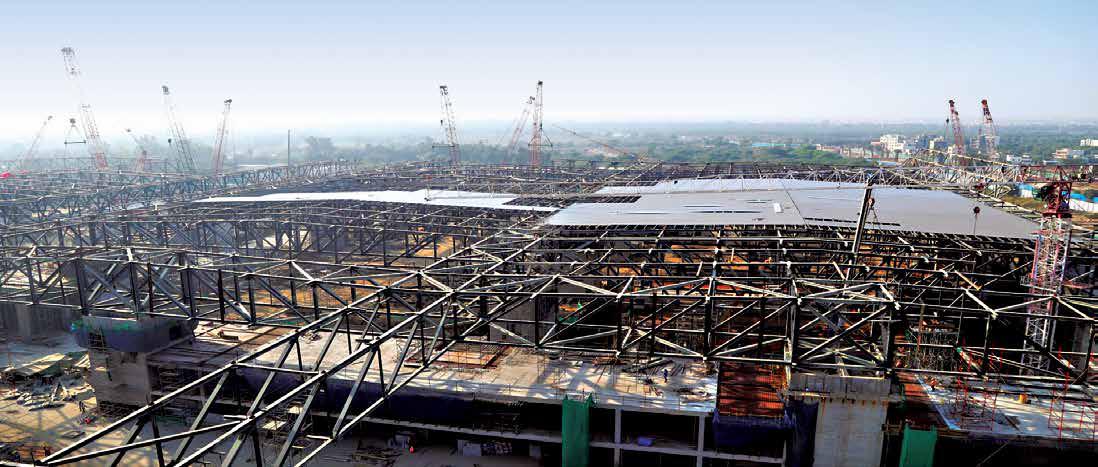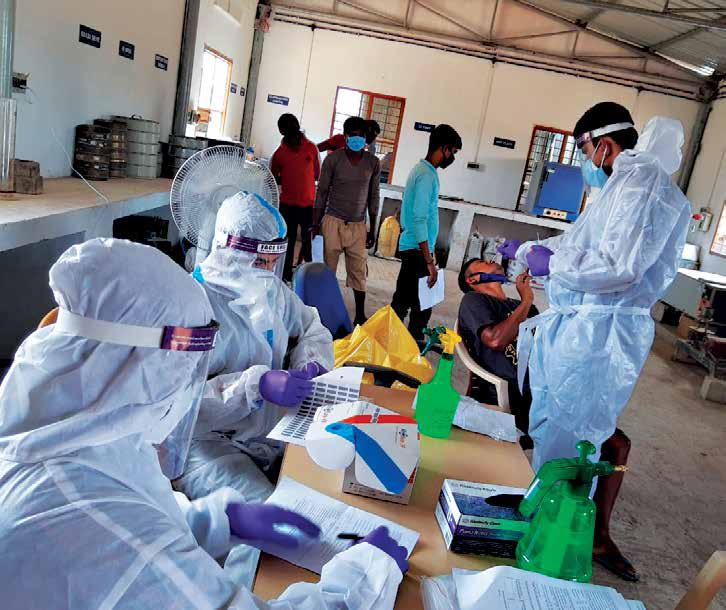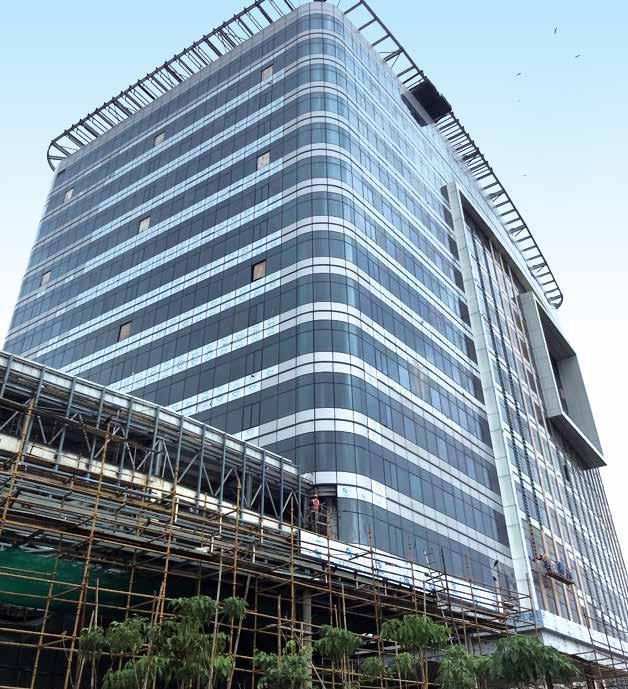B&F SITES RISE TO COVID-19 CHALLENGES!
Project Manager Girish P Kumar, RAMCO Kolimigundla project, constructing a 8000 TPD Greenfield cement plant, had just begun to feel good about achieving about 15000 cum of concrete and 1000 MT of fabrication work monthly with a strong workforce of nearly 1800 when the pandemic struck. Overnight, Girish had new priorities and a new normal to contend with. For starters, his workforce slipped to a mere 200, with equipment left to idle.

“Our first step was to reconstruct our workforce by transporting migrant workmen back to our site,” says Girish, “by liaising with district collectors and other Government officials. Initially, we succeeded to identify and mobilise 650 workmen in just 20 days after the lockdown with whom we cast a major pour of 2000 cum, the cluster’s first significant pour.” Girish revels in his team’s achievement. Despite the restrictions on movement of workmen from other states, the site managed to bring back about 1500 workmen. To make up for lost time and meet the customer’s requirements, the workmen camp was expanded, and a night shift introduced. “All said and done, we
are back in the thick of action,” Girish energetically confirms.

“Initially, we succeeded to identify and mobilise
650 workmen in just 20 days after the lockdown with whom we cast a major pour of 2000 cum, the cluster’s first significant pour.”
Girish P Kumar
Project Manager,
RAMCO Cement Plant, Kolimigundla

RAMCO Kolimigundla
200 to 5,400 in just 3 months!
At the India International Convention Centre (IICC), Dwarka, the pandemic demanded a delicate balance: protecting the health of workmen, demonstrating compliance with local regulations, managing client and supplier expectations and synergising with internal teams—all the while achieving productivity and project milestones. After making steady progress till end February by completing 65%+ of the project with a workforce of 4500, work ground to halt from 21st March. Soon, only 150-200 labour remained at site.

India International Convention Centre, Dwarka
Unlock 1 gave IICC’s Project Director, V. Ramesh the opportunity to return to action but could not have achieved much with his thin workforce. “With HQ’s support, we drew up a detailed plan to mobilize workmen from almost every Indian state,” he says, with separate task teams networking with each state. “We even deputed some of our people to travel to places to liaise with local authorities for permissions, do the paperwork, arrange for buses or train tickets and ensure their safe transit to site.” Meanwhile, the site administration team (Accounts, Time Office) got busy getting the site ready to accommodate this influx of new workmen following all the SOPs. “Our plan worked,” Ramesh shares a thumbs up. “Within three months, we had close to 4,000 workmen at site and currently we have touched 5,400,” signalling the removal of a huge roadblock for progress.

“Our plan worked. Within three months, we had close to 4,000 workmen at site and currently we have touched 5,400.”
V. Ramesh
Project Director,
India International Convention Centre, Dwarka
Ramesh enjoyed the support of the structural steel erection and fabrication teams who maintained continuity of work at site even under a restricted working environment during the lockdown. Several employees moved temporarily to company provided accommodations near the site to avoid unnecessary travel. The Architecture and Design teams continued to work from home successfully getting a huge quantum of design and documentation approvals by effectively coordinating with the PMC and the client.
Ramesh is delighted that his mega project is back on track for the numbers are showing. “Since resumption of operations in June, we have completed 6000 MT structural steel erection, 20,000 cum RCC work, nearly
2,500 sqm of dry wall partition work, 4,500 sqm of roof sheeting, 10,000+ sqm of ducting, 3,000+ rmt of ICT containment work and 15,000+ rmt of conduiting work. Of course, we still have miles to go,” he smiles and dives straight back into his work.

“We closely coordinated with subcontractors located in various states to arrange buses, train tickets for workmen followed by the due diligence of identity verification.”
Parwez Ahmed Khan’s
Assistant Manager – IR,
India International Convention Centre, Dwarka
The success of project sites in their effort to re-mobilize labour depends to a large extent on their equation with the subcontractors as Assistant Manager – IR, Parwez Ahmed Khan’s at the IICC Project at Dwarka in New Delhi, shares. “We closely coordinated with subcontractors located in various states to arrange buses, train tickets for workmen followed by the due diligence of identity verification,” praising the digital solution, WISA, in making new workmen inductions easy and efficient.

India International Convention Centre, Dwarka

“Being a new site, we had very few workmen in hand, but my team collectively rose to the occasion and we mobilized 700 workmen in just two months”
G Suresh
Project Manager,
Prestige Finsbury Park, Bengaluru
With only two trains operating from Bihar and West Bengal, the task to restore his workmen strength for Project Manager, G Suresh at the Prestige Finsbury Park project in Bengaluru was an onerous one. “Being a new site, we had very few workmen in hand, but my team collectively rose to the occasion and we mobilized 700 workmen in just two months.” Apart from proactive mobilization, Suresh’s was the first B&F project to initiate Pool Test for workmen. They actively developed vendors to ensure timely procurement of materials and ensure smooth progress of work.

Pool testing for COVID at Prestige Finsbury Park

Assam Cancer Care Foundation Hospital, Dibrugarh
Workmen mobilization and retention had been massive challenges for Project Head, Rana Dhar at the Assam Cancer Care Foundation project at Dibrugarh right from the beginning of the project. “We had mobilized
120 workmen from Bihar, West Bengal and Jharkhand just before the lockdown. Retaining them during and after the lockdown was a major task,” he says, furrowing his eyebrows in worry. “We also had a critical task to complete casting the hospital raft before the severe Assam monsoon set in that stretches from April all the way to October. Else, we stood to lose a good 3-4 months in dewatering alone.” Realizing the gravity of the situation, Rana approached the client and received the District Collector’s permission to resume minor construction works like shuttering and reinforcement from April 2nd with reduced manpower scattered across the site, though strictly adhering to all the SOPs. “Initially it was difficult to manage the workmen, but we supported them and they, in turn, reciprocated. The district administration supported us by arranging passes for vehicles to deliver cement, steel and bulk material in time and ultimately, we completed casting the raft on 13th May,” his tone signalling a huge triumph both for himself and his team.

“We also had a critical task to complete casting the hospital raft before the severe Assam monsoon set in that stretches from April all the way to October. Else, we stood to lose a good 3-4 months in dewatering alone.”
Rana Dhar
Project Head,
Assam Cancer Care Foundation Hospital, Dibrugarh

Chennai International Airport

Bengaluru International Airport Limited
Airport projects take off
At the BIAL site, a charged team of Kaliyan S, Hemant Kumar Jaluka, Narendra Mutalik Desai, Vijaykumar Muthukumar, Ganesh Kannan, Murali K and Sai Sundar HV worked overtime to reshape their resource mobilization strategies and operating procedures, to emerge stronger and spur positive change in the heat of the pandemic. Their days were action-packed, liaising with government officials, conducting pool COVID tests for every group of 5 people before deployment, working closely with the railway department to mobilize workmen from Bihar, Jharkhand, West Bengal, Odisha and arranging nearly 2200 bus and train tickets till August, thanks to which they have managed to improve their workmen strength to 3250 by September.

“We had initially mobilized 1306 workmen in 64 days in 36 buses. By July end, we had
950 workmen and, by August end, 1860.”
Anup Chulliyil
Project Manager,
Chennai International Airport
With buses reaching workmen safely to site, Project Manager, Anup Chulliyil’s workmen mobilisation effort has been a runaway success. “We had initially mobilized 1306 workmen in 64 days in 36 buses,” he shares. “By July end, we had 950 workmen and, by August end, 1860.” The above measures implemented by the site EHS and Admin teams not only prevented the spread of the pandemic at site, but also furthered the progress of the project and boosted the morale of the workers and staff.

“We liaised with government officials and conducted pool COVID tests for every group of 5 people before deployment. We worked closely with the railway department to mobilize workmen from Bihar, Jharkhand, West Bengal, Odisha and arranged nearly 2200 bus and train tickets till August, thanks to which we improved the workmen strength to 3250 by September.”
Shivarajjayadevappa Kubsad
Project Director,
Bengaluru International Airport Limited, T2
A B&F project that was among the first off the blocks with the Unlock was the MVDC Cheyyar project that resumed operations on 27th April thanks to some forward thinking. During the lockdown itself, the project team led by Project Manager, Raghuraman Sadagopan, mobilized local workmen and trained them to perform activities like pitching, shuttering, reinforcement tying and more. “Not only did we manage to keep the project progressing by executing some critical activities as per the client requirements but have also given these locals a means of livelihood during these difficult times,” shares a satisfied Raghuraman.

“We communicated with our key supply chain stakeholders on volumes and changes to new volume demands for the next few quarters to ensure that work proceeds smoothly.”
Malhari Naik
Project Manager,
LTR Powai,Mumbai
Bolstering supply-chain resilience
With supply chains disrupted, project teams have been scrambling to restore distribution lines with specially created task forces. Undoubtedly, the problem has been magnified for projects dependent on global sourcing like the LTR Powai project. Located in Mumbai, Project Manager, Malhari Naik had the additional threat of the oncoming monsoon that traditionally disrupts work big time. Working with purpose, they set up a temporary inventory recovery and evaluation process, pursuing alternative sourcing strategies. “We communicated with our key supply chain stakeholders on volumes and changes to new volume demands for the next few quarters to ensure that work proceeds smoothly.” When the lockdown was announced, finishing, structural steel, MEP, façade, and interior works were in progress.

LTR Powai
The task before Malhari and his team was to resume operations smoothly without the services of adequate number of skilled workmen. “We worked jointly with all NSC agencies to mobilize workmen while internally, we re-prioritized our work as per the available resources at the appropriate work fronts,” says Malhari, who has successfully moved the needle of progress at his site.

“Not only did we manage to keep the project progressing by executing some critical activities as per the client requirements but have also given these locals a means of livelihood during these difficult times.”
Raghuraman Sadagopan
Project Manager,
MVDC Cheyyar Project
Other project teams are actively reviewing their supply chains for vulnerabilities and fortifying themselves by building inventories, identifying backup distribution channels, or alternate sources of supply.
Investing in skills and technology to operate in the next normal
It is always critical to balance performance and health, more so in these turbulent times. Some project teams however found the time opportune to upskill the workforce by imparting training on new tools, technologies, and operating procedures. Focussing on digital transformation, virtual training sessions for employees were conducted on the latest digital technologies through 7 webinars with 1700 participants and 250+ virtual safety audits to ensure that safety remained the top priority.
Before this pandemic, digital solutions drove construction efficiency, timely completion, and profitability of projects. The post COVID-19 world is already seeing a fresh push for digital transformation to address the specific challenges posed by the pandemic. Time is of the essence and as project teams up the ante to make up lost ground, technology, prefab, pre-cast, volumetric and modular construction will be their allies to build faster, more economically and with improved productivity. As for now, though, the Phoenix has risen from the
ashes of COVID-19!